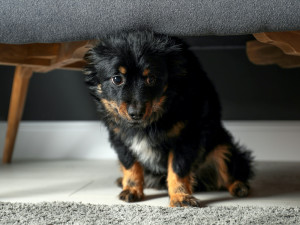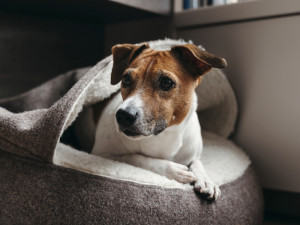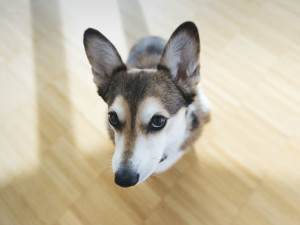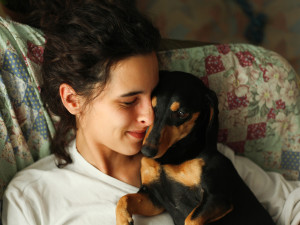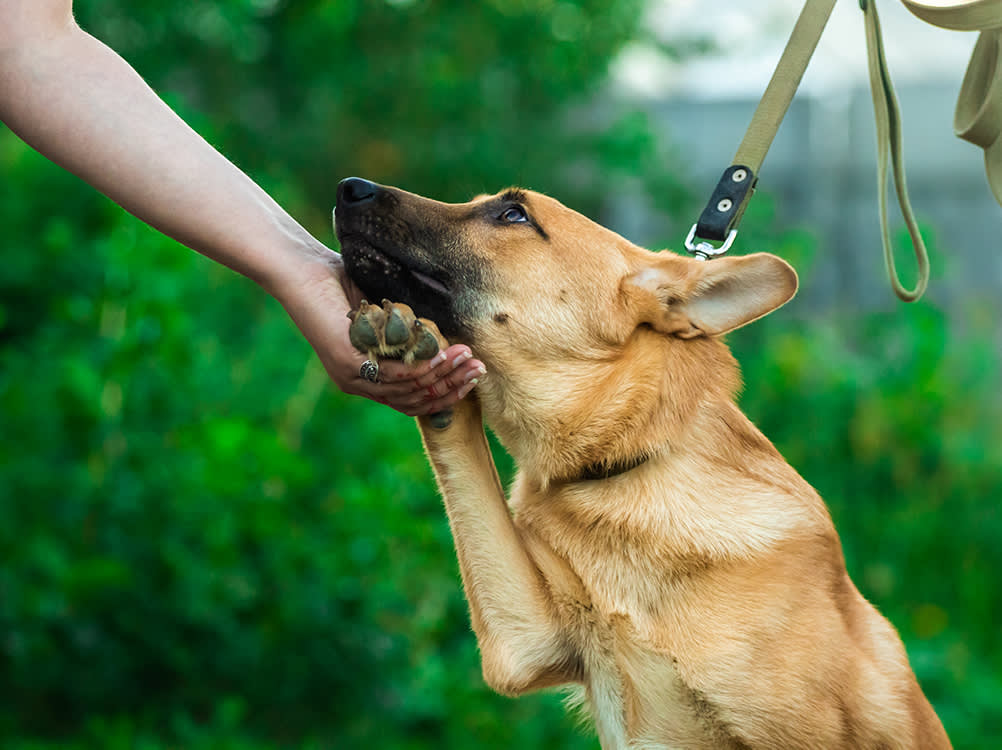
Share Article
Most humans know how paralyzing anxiety can be, especially these days. But it sometimes feels like the dog world is polarized between people who “get” anxious and nervous dogs and people who don’t. Worse, the humans who don’t understand dog anxiety can be dismissive and unkind, not to mention make it difficult for you to navigate the world with your pup by not respecting personal space.
Lately, however, people are coming to realize that completely calm, bombproof dogs are closer to the exception than the rule. Many dogs have something they’re not comfortable with, whether it’s alone time, storms, cats or children. This increased awareness has translated into easier tactics. First up, let’s go over typical behaviors of a dog with anxiety or nervousness.
What Are Signs Of Dog Anxiety?
Knowing the common signs a dog may exhibit can assist pet parents in figuring out what is causing the anxious or nervous reactions.
Excessive barking and howling
Excessive whining
Aggression
Panting or drooling excessively
Digging or scratching repetitively
Depression
Pacing or restlessness
Compulsive behaviors like unusual chewing
Urinating or defecating in the house
Trembling or shaking
When a dog becomes stressed and anxious, oftentimes this distress manifests in symptoms that mimic misbehavior. If your dog is experiencing some of the common symptoms of nervousness, you may be wondering what you can do to help.

Tips On How To Reduce Dog Anxiety
Here are eight ways to make life with your anxious (or nervous) dog better for both of you.
1. Seek out a positive reinforcement dog trainer.
In recent years, modern trainers have learned that an overwhelming majority of dogs who lunge at, bark at and fight with other dogs and humans aren’t doing so because they’re “dominant” or because they want to be “pack leader.” They’re doing it because they’re scared. A frightened dog, especially one who feels like they can’t escape, will turn to aggression to “get him before he gets me.” Once we know that aggression is rooted in fear, we know to avoid trainers who “rehabilitate” aggressive dogs by dominating them.
Hurting a dog with anxiety doesn’t stop them from being scared, it just makes them shut down. Change the emotion, on the other hand, and you’ll change the behavior. A dog who isn’t scared of other dogs has no need to bark or fight. Find a good dog trainer, ideally one who follows positive reinforcement principles and is certified by CCPDT, and you can work wonders together.
2. Make the dog visible.
This might sound like the last thing you want to do with an anxious dog — I’ve certainly spent my share of time hiding around corners and not opening my door until I’ve checked that the coast is clear — but drawing attention to your dog’s anxiety is a good way to tell other people not to approach. Put a yellow ribbon on your dog’s leash, or buy a bandanna or harness that says “nervous” or “no dogs” and you’re giving people a heads-up without having to yell at them.
3. Muzzle the dog up.
If your dog has anxiety about other dogs and is big enough that you could lose control if they lunge, consider a good quality muzzle. A muzzled dog is still seen by most people as a dangerous dog, which can lead to some unpleasantness for the owner, but thankfully, the Muzzle Up! Projectopens in new tab is trying to get rid of that prejudice and spread the word that a muzzle is a sign of a responsible owner and a safe dog. By making those with aggressive dogs feel safer, muzzles allow both people and dogs to get more enjoyment from being outside.
4. Consider changing your vet.
While some vets are great with nervous and aggressive dogs, others are still very old school; they don’t listen to owners and use invasive and rough handling. There are, however, new techniques out there for vets dealing with anxious dogs. Dr. Sophia Yinopens in new tab developed a program for vets that focuses on low-stress handling, which can make a huge difference in your dog’s anxiety levels. And Dogs in Need of Spaceopens in new tab has a list of vets who go the extra mile for anxious dogs; if you do want to change your vet, it’s a good place to start.
5. Learn your dog’s body language.
Your dog constantly communicates how they’re feeling, and the better you understand what they’re saying, the easier it can be to avoid stressful situations. Something that was fine for them last week might be too much for them to cope with today due to a phenomenon called trigger stacking (an increase in dog anxiety-related behaviors caused by them experiencing repeated stressful events without enough time in between for the associated stress hormones to leave the system). Avoid this by keeping an eye out for signs that tell you how your dog is feeling.
6. Consider medication.
You might be thinking but what can I give my dog for anxiety? When I tell people, “My dog’s on Prozac,” most of them laugh; they think it’s a funny way of talking about dog anxiety. It’s not: she really is on Prozac. Many of the same antidepressant medications that millions of humans use have been proven to help dogs with anxiety have the confidence to try new behaviors.
A conversation with your vet is the first step on this route. Your vet can refer you to a veterinary behaviorist, a DVM who is knowledgeable about both training and medication; a vet behaviorist can give you a complete prescription tailored to your dog’s needs and, ideally, liaise with your trainer or applied animal behaviorist (a professional who specializes in dogs with behavioral problems but is not a vet).
Making the decision to try medical intervention can seem like a big step, but there is a lot of specialist information designed to make it easier. A good place to start is Debbie Jacob’s website, fearfuldogs.comopens in new tab. There are also numerous over-the-counter pills and products marketed to help anxious dogs, but be careful if you choose to experiment with them. Most “calming supplements” haven’t been tested, and evidence for the ones that have been is sketchy at best. Ultimately, it’s a personal choice, but do remember that treatment has its own kind of placebo effect.
7. Find a shared interest.
It’s okay to be disappointed that your dog doesn’t want to go to the dog park, agility trials or pavement cafés. Try focusing on what you guys can do together instead. Set up indoor obstacle courses, go on quiet wilderness hikes, take nose-work classes or just chill at home. Don’t try to force the dog you have to be the dog you wanted. In the end, you’re likely to make their problems worse, not to mention strain your relationship.
8. Know your limits.
If you’re really out of your depth, or your dog represents a serious danger to you or your children, it’s okay to consider rehoming. Training and medications are expensive, and anxious dogs often require a lifetime commitment. In some cases, it’s safer for you and better for the dog to find a new home where they can get what they need if you don’t have the resources or the situation to provide it. You’re not a bad person or a failure — you’re making the wisest, kindest choice in the circumstances.

Tiro Miller PhD, SBA
Tiro Miller, PhD, is managing editor of the International Association of Animal Behavior Consultants’ online journal, volunteers at the San Francisco SPCA.
Related articles
![Sad boxer rests on owners lap, dog doesn't want to be touched]()
How to Tell if Your Dog Is in Pain
And what to do to help them.
![A dog looking timid in his bed]()
How to Help Thunder-Phobic Dogs
Tips for comforting your pup when the storm is too loud for your pup’s comfort.
![A dog looking up with a cute face]()
How to Get Your Scared Dog to Trust You
Using these tips, your skittish dog will warm up to you.
![Young woman hugging her small black dog on the couch]()
Who Has More Separation Anxiety — You or Your Dog?
It was a trick question. A study shows that the pandemic has made us all codependent.

